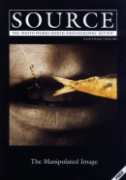Hung Like a Donkey Jacket
Photographs by Karl Fulton - Old Museum Arts Centre, October, 1994.
Review by Jennifer Dempsey
Issue 3 Winter 1994
View Contents ▸
Hung Like a Donkey Jacket, on display at the old Museum Arts Centre, October 1994, is a collection of black and white photos depicting the life of workers in the Greater Belfast power industry.
Somewhere between the landfills and machines, the buildings and the tools, are the men; and the photographer Karl Fulton has tried to show us who they are.
The faces that appear in this collection give off the same expression, whether they are sitting in what looks like a changing room, standing outside the power plant, or walking down a long hallway going to get to work on something. From Hung Like a Donkey Jacket by Karl Fulton.
From Hung Like a Donkey Jacket by Karl Fulton.
And that expression is; You're finding this a hell of a lot more interesting than we are.
The first face that caught my eye was the older man, standing in a dark closet-type room with a lightbulb shining over his head. He's wearing a hard-hat, holding a cup of coffee and standing next to a grey wall with graffiti written all over it. There's a picture of a naked woman on the window, not far from his head.
He looks out at the camera and says "This is who I am. Big deal. Why do you want to take a photo of it."
He is apologetic and unphased and I liked him immediately.
As a viewer I found that the pornography appearing in the background of some of these photos looks a lot like warmth and life next to the coalheaps and machines.
Another image shows a man holding a powerdrill like a gun. He's wearing glasses and looking slightly uncomfortable being looked at. I am reminded of a bored British soldier parading up and down a deserted street somewhere in Belfast.
The other men shown here are either having a rest, having a laugh, or having their picture taken beside the tools. None of them look like they care what the camera thinks. All of them look like they can't quite figure out what the photographer wants them for.
And that's why I like this exhibition. It feels true to these men, that they are not posing, even when they are standing still for the camera.
That's also why I like these men. They seem hard-working and down to earth, unselfconscious and honest; their work is more important to them than any photo essay.
I don't know much about the Greater Belfast power plant. I don't know what changes are taking place there.
But I like what Karl Fulton has revealed to me about the men who work there.
Other articles by Jennifer Dempsey:
Other articles on photography from the 'Portraiture' category ▸






